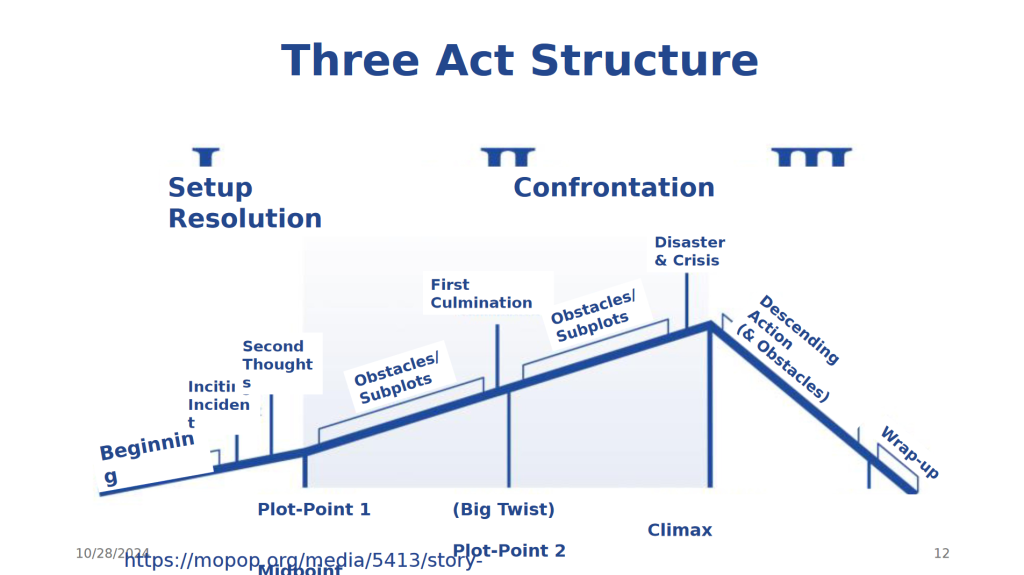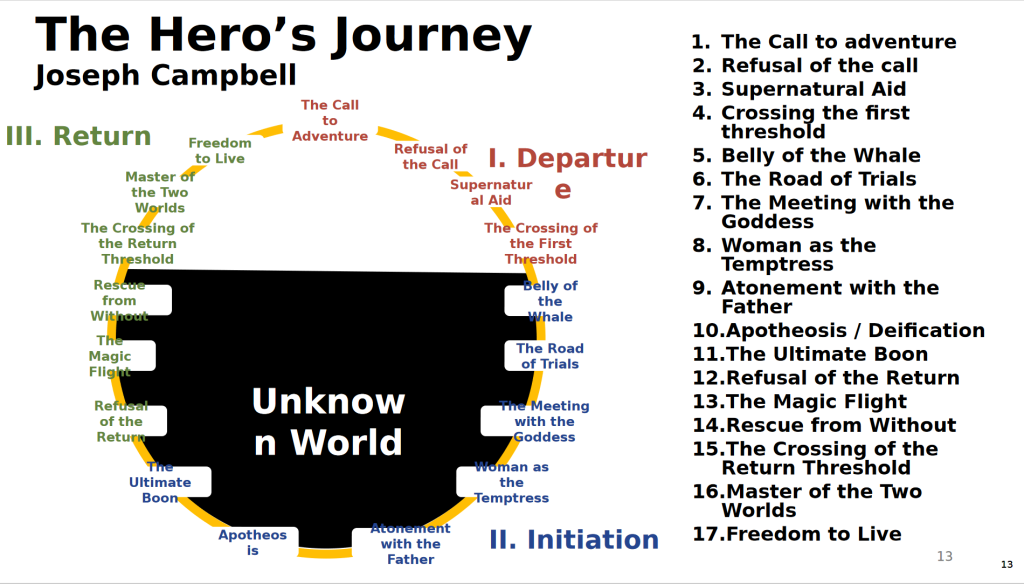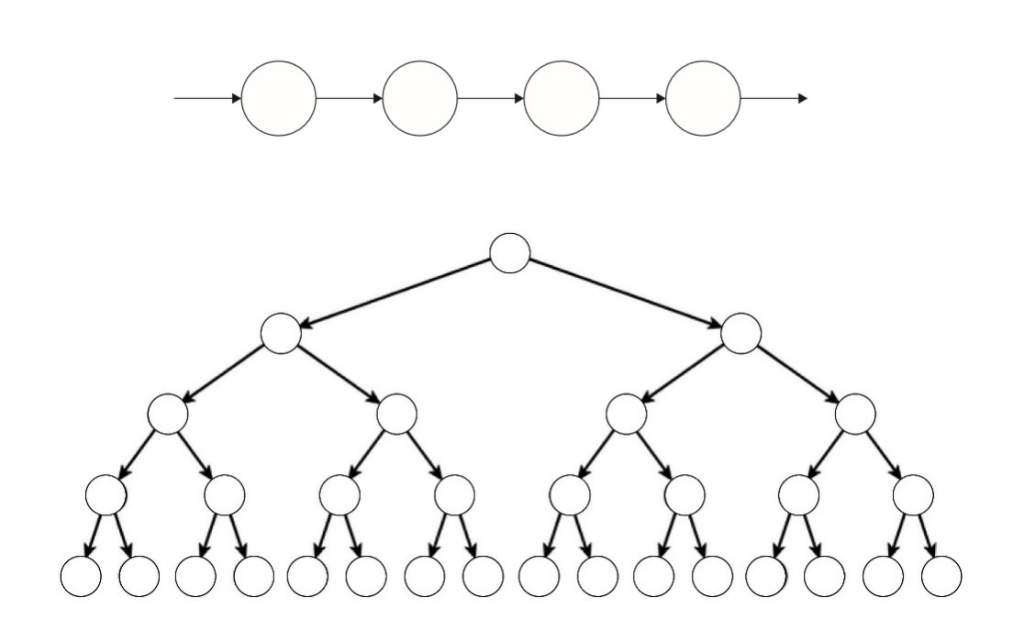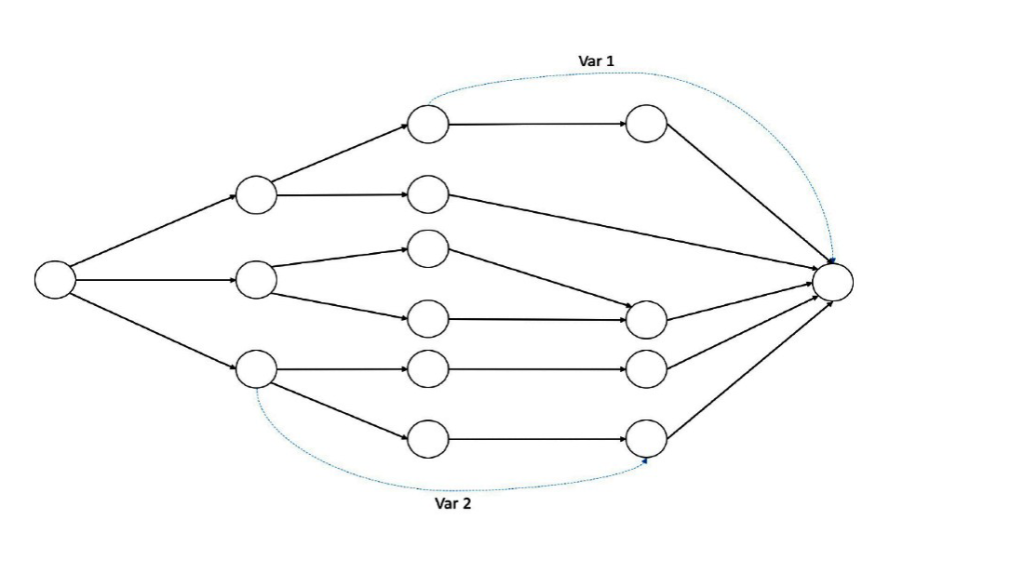For our fifth week we looked at narratives in games, and how to translate a narrative onto something as flexible and interactive as a game. Some games, particularly older ones such as Space Invaders, appear not to have a narrative at all – but isn’t the player playing the game not a story in of itself? A good game generates stories when people play it. This principle is dubbed by game designer Jesse Schell as “The Story Machine”.
Even if there is no story, elements of the world can still convey a narrative through design alone. For example, world items and the environment can convey a lot of information about the type of place you’re in, creating a mini-narrative.
Narratives can take a lot of “shapes”. The most famous example is the Three Act Structure in the shape of a hill, with a slow rise on one end to signify the beginning and set up the conflict, which will eventually lead to a crisis at the peak, and then descend sharply down to wrap up the story.

Another example is “The Hero’s Journey” by Joseph Campbell, a circular structure of three main parts:

But these are for more traditional story mediums such as literature and theatre. The most important part to keep in mind for games is that on a medium based on interactivity, choices matter – therefore the impact and consequences of these choices need to matter. So in games, the structure will look more like this:


Guest Speaker: Amber Boothe on Narrative and Character Design
Amber works for Nobody’s Fool, a murder mystery game company that originated when her friend wanted to do something fun for her birthday during lockdown, without the mess of online calls risking people talking over each other – something organised. Nobody’s Fool host and supervise murder mysteries for parties upwards of 20, and so Amber has become very adept at telling good, roleplaying stories with a satisfying twist.
The Rules of Murder Mystery:
- Play by asking questions
- Share your character information
- Don’t lie about your secret information
- Don’t make up information
- N.B: The murderer doesn’t know they are the murderer.
The game is additionally designed so that even if the murderer accidentally blurts out they’re the murderer, the game is still fully playable.
Elements of a murder mystery:
- Concept
- Premise
- Characters
- Logic
CONCEPT:
- A murder mystery game inspired by X for Y players
- Eg; Inpsired by Agatha Christie for casual players who like board games. Eg 2; inspired by DnD for seasoned TTRPG players.
PREMISE:
- Set up: characters at location because…
- Twist: X is actually Y
- Eg; Setup: A ragtag band of pirates are sailing cursed waters because they are searching for treature. Twist: the treasure is deadly.
- The twist should be distinct from the murderer’s plotline. The shorter and more succint, the stronger the concept.
ESSENTIAL CHARACTERS:
- Victim (NPC)
- Secondary victims (NPC) – the motive for murder. Can be people, animals, or concepts (eg; career)
- Mastermind – the architect of the twist. Should not be the murderer, because then one player gets too much key information.
- Murderer – the person with the means, motive, and opportunity. There should only be 1 murderer, and the murderer should have murdered intentionally. Multiple murders make a harder to design/harder to solve game, and accidental murders are more boring.
SUPPORTING CHARACTERS:
- Lover – agent of chaos motivated by love, lust, or obsession. Easy motive for people doing crazy things
- Fool – clumsily or carelessly wreaks havoac. Usually good-hearted.
- These characters should corroborate key information about the Victim, Mastermind, and Murderer.
- Other characters: Blackmailers, assassins, merchants, amnesiacs, innocent witnesses, and police/inspectors.
LOGIC:
- The victim hurt or killed the secondary victim
- The murderer cares deeply for secondary victim
- The murderer attacks the victim to avenge secondary victim
- The twist makes it harder to catch the killer because…
- The murderer killed the wrong person
- The murder weapon is unusual
RULES TO KEEP IN MIND:
- Keep the story SIMPLE
- The players will find ways to complicate things – especially a large group.
- Red Herrings are annoying
- If you’re including one, the plotline can’t lead to a dead end: the players must glean SOMETHING
- People are expecting murder, not tragedy.
- The victim is not generally someone to be pitied. The murder is the fun part!! Don’t make it sad.
- Expect players to arrive unprepared, and let them know that’s okay
- Players are smarter and more creative than you are, so don’t get discouraged by errors.
- Tell players what they don’t know
WORKSHOP
Title: Siren Night
Logline: It’s on a boat
Inspired by sea mythology for first time players who enjoy fun and mystery.
Setup: The boat is comprised of humans and a secret siren. Then one day, the Captain falls dead!
Twist: the Captain’s Daughter killed her father to be with the Siren, whom she fell in love with.
Double Twist: the siren doesn’t even love the Captain’s Daughter, but is steering the boat towards her Siren friends for a feast
Characters:
- The Captain (dead from jellyfish poison), Captain Miranda
- The Captain’s Daughter, Eliza
- The Siren in Disguise as the Navigator (steering them off course), Maria
- The secondary victim is LOVE
- Doctor (assess the body) Mr. Hook
- First Mate (closest person to the Captain, had a recent disagreement with him Captain), Mr. M. Binder
- Quartermaster (mantains day to day life on the ship), Mr. Howard
- NPC’s can be the rest of the staff
Logic:
The Captain hurt the Captain’s Daughter by telling her she could never be with the Navigator.
The Captain’s Daughter cares deeply for the Navigator, having fallen in love with her.
The Captain’s Daughter kills the Captain to be with the Navigator.
The twist makes it harder to catch the killer, because nobody except the Captain’s Daughter and the Captain knew the Navigator is actually a Siren. Double Twist: The Siren as the Navigator doesn’t care for the Captain’s Daughter, and is intent on steering the ship towards rocks to kill and eat everyone here.
Extra Plot Points:
- The Captain left a note that said “BEWARE THE SIREN”, indicating that one of the players are not what they seem to set up the doppleganger twist.
FEEDBACK:
- How does the love plot affect other characters
- The secondary twist is good and surprising; not where you’d traditionally expect the twist to be
This workshop was very fun to create, and informed me on how to break down a story, particularly a mystery, into simple elements that won’t overcomplicate the plotline – something I have often been guilty of. While not directly relevent, it helped me construct my own narrative.

Leave a Reply